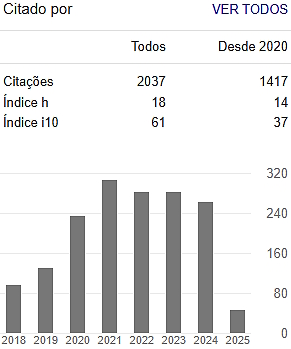Evaluation of phytopathogens incidence in basic and commercial bean seeds in the State of Paraná, Brazil
Keywords:
seeds pathology, common bean, micology, sanityAbstract
The present study aimed to isolate endophilic fungi from plant tissues (leaves, stems and roots) of beans, in addition to identifying them at the genus level. The experiment was conducted at IDR-Londrina. Bean samples were collected at the Londrina Research Station and at UENP-Bandeirantes. The leaves, stems and roots were separated, fragments of 5 mm diameter were cut and disinfested. They were later transferred to BDA culture medium. The plates were incubated at room temperature for seven days for growth of the microorganisms present. The presence and absence, colonization rate (TC) for each tissue and gender identification of fungi were evaluated. The experiment was conducted in a completely randomized design, with five replications. Forty-eight endophilic isolates were found, 13 in root, 17 in stem and 18 in leaf. CT ranged from 17-100% (leaf), 17-83% (stem) and 16-100% (root). The genus Alternaria sp. and Cladosporium sp. have greater specificity with the leaf and stem, Penicillium sp. root and stem. The genera Fusarium sp. and Aspergillus sp. are found in all organs, Curvularia sp., Nigrospora sp. and Thichoderma sp. demonstrated leaf specificity, Macrophomina sp. the root, and Colletotrichum sp. to the stem.
Downloads
References
AGUIAR MENEZES, E. de L. Controle biológico de pragas: princípios e estratégias de aplicação em ecossistemas agrícolas. Seropédica: Embrapa Agrobiologia, 2003. 44 p. (Embrapa Agrobiologia. Documentos, 164). https://www.embrapa.br/en/busca-de-publicacoes/-/publicacao/625667/controle-biologico-de-pragas-principios-e-estrategias-de-aplicacao-em-ecossistemas-agricolas
ARAÚJO, W.L.; SARIDAKIS H.O.; BARROSO, P.A.V.; AGUILAR-VILDOSO, C.I.; AZEVEDO J.L. Variability and interactions between endophytic bacteria and fungi isolated from leaf tissues of citrus rootstocks. Canadian Journal of Microbiology, 47, p. 229-236, 2001. https://doi.org/10.1139/w00-146
AZEVEDO, J. L.de. Biodiversidade microbiana e potencial biotecnologico. In: Ecologia microbiana EMBRAPA CNPMA, Jaguariúna, 1998. https://livimagens.sct.embrapa.br/amostras/00064430.pdf
BARBOSA, F. R.; GONZAGA, A. C. de O. Informações técnicas para o cultivo do feijoeiro-comum na Região Central-Brasileira: 2012-2014. Embrapa Arroz e Feijão-Documentos (INFOTECA-E), 2012. https://www.infoteca.cnptia.embrapa.br/bitstream/doc/926285/1/seriedocumentos272.pdf
CASTELLANI, A. Viability of some pathogenic fungi in distilled water. Journal of Tropical Medicine & Hygiene, Baltimore, v.24, p.270-276, 1939. https://ci.nii.ac.jp/naid/20001660991/
CHRISTMANN, P. E. T. P. Produtos alternativos aplicados na cultura do feijão para controle da antracnose. 2019. http://tede2.uepg.br/jspui/handle/prefix/2797
CONAB. Companhia Nacional de Abastecimento 2019. Disponível em: https://www.conab.gov.br/info-agro/analises-do-mercado-gropecuarioeextrativista/analisesdo-mercado/historico-mensal-de-feijao.
DEFANTE, L. R.; NASCIMENTO, L. D. O.; LIMA-FILHO, D. de O. Comportamento de consumo de alimentos de famílias de baixa renda de pequenas cidades brasileiras: o caso de Mato Grosso do Sul. Interações (Campo Grande), v. 16, p. 265-276, 2015. https://doi.org/10.1590/151870122015203
GAMBOA, M. A.; LAUREANO, S.; BAYMAN, P. Measuring diversity of endophytic fungi in leaf fragments: does size matter? Mycopathologia, v. 156, p. 41-45, 2003. https://doi.org/10.1023/A:1021362217723
GONZAGA, A. C. O. Feijão: o produtor pergunta, a Embrapa responde, 2 ed. rev. e ampl., 2014. 247 p. http://www.infoteca.cnptia.embrapa.br/infoteca/handle/doc/1014894
JALGAONWALA, R. B.; MOHITE, B. V.; MAHAJAN, R. T. J. A review: Natural products from plant associated endophytic fungi. Journal of Microbiology and Biotechnology Research, v. 1, n. 2, p. 21-32, 2011. http://scholarsresearchlibrary.com/archive.html
MAGALHAES, Wagner Carlos Santos et al. Diversidade de fungos endofíticos em candeia Eremanthus erythropappus (DC.) MacLeish. Cerne, v. 14, n. 3, p. 267-273, 2008. https://www.redalyc.org/pdf/744/74411656011.pdf
MARIANO, R.L.R.; LIRA, R.V.I.; SILVEIRA, E.B.; MENEZES, M. Levantamento de fungos endofíticos e epifíticos em folhas de coqueiro no Nordeste do Brasil. I. Frequência da população fúngica e efeito da hospedeira. Agrotópica, 9, 3, p. 127-134, 1997. https://www.scielo.br/j/abb/a/yDMdNsTrkqwnk4KWcSXD54P/?lang=pt
PEREIRA, J. O.; CARNEIRO-VIEIRA, M. L.; AZEVEDO, J. L. Endophytic fungi from Musa acuminata and their reintroduction into axenic plants. World Journal of Microbiology and Biotechnology, 15, p. 37-40, 1999. https://doi.org/10.1023/A:1008859823806
PETRINI, O.; STONE, J.; CARROLL, F. E. Endophytic fungi in evergreen shrubs in western Oregon: a preliminary study. Canadian Journal of Botany, 60, p.789-796, 1992. https://doi.org/10.1139/b82-102
PHOTITA, W.; LUMYONG, S.; LUMYONG, P.; HYDE, K.D. Endophytic fungi of wild banana (Musa acuminata) at Doi Suthep Pui National Park, Thailand. Mycological Rasearch, 9 105, 12, p. 1508-1513, 2001. https://doi.org/10.1017/S0953756201004968
POSSE S. C. P., SOUZA E. M. R., SILVA G. M., FASALO L. M., SILVA M. B., ROCHA M. A. M. Informações técnicas para o cultivo do feijoeiro-comum na região central brasileira: 2009-2011. 2010. https://biblioteca.incaper.es.gov.br/digital/bitstream/item/975/1/Livreto-Feijao-AINFO.pdf
ROCHA, R.; LUZ, D. E.; ENGELS, C.; PILEGGI, S. A. V.; JACCOUD FILHO, D. S.; MATIELLO, R. R.; PILEGGI, M. Selection of endophytic fungi from comfrey (Symphytum officinale L.) for in vitro biological control of the phytopathogen Sclerotinia sclerotiorum (Lib.). Brazilian Journal of Microbiology, São Paulo, v. 40, n. 1, p. 73- 78, 2009. https://doi.org/10.1590/S1517-83822009000100011
SALVADOR, C.A. Análise da conjuntura agropecuária safra 2011/12. Feijão. Disponível em: http://www.agricultura.pr.gov.br/arquivos/File/deral/feijao_2011_12.pdf
SEAB. Secretaria de Estado da Agricultura e do Abastecimento. 2014. Feijão: Análise da Conjuntura Agropecuária. Disponível http://www.agricultura.pr.gov.br/>.
SILVA, R.L. de O; LUZ, J.S.; SILVEIRA, E.B.; CAVALCANTE, U.M.T. Fungos endofíticos em Annona spp.: isolamento, caracterização enzimática e promoção do crescimento em mudas de pinha (Annona squamosa L.). Acta Botânica Brasilica. v. 20, n. 3, p. 649-655. Brasília. 2006. https://doi.org/10.1590/S0102-33062006000300015
SNA. Sociedade Nacional de Agricultura. 2019 Disponível em: https://www.sna.agr.br/producaoeconsumo-nacional-de-feijao-continuam-os-mesmos-ha-mais-de-10-anos/
Downloads
Published
Issue
Section
License
Copyright (c) 2022 Colloquium Agrariae. ISSN: 1809-8215

This work is licensed under a Creative Commons Attribution-NonCommercial-NoDerivatives 4.0 International License.

